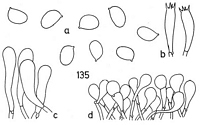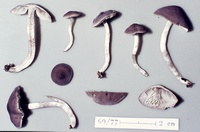|
 Dermoloma hemisphaericum Dermoloma hemisphaericum
SynonymsTricholoma hemisphaericum
BiostatusPresent in region - Indigenous. Endemic
Images (click to enlarge)
Caption: 135-Dermoloma hemisphaericum: a. spores; b. basidia; c. caulocystidia;
d. cuticle. | 
Caption: ZT69-077
Owner: E. Horak: © Creative Commons Attribution-Noncommercial 3.0 New Zealand | 
Caption: Fig. 26 |
Article: Stevenson, G. (1964). The Agaricales of New Zealand: V. Kew Bulletin 19(1): 1-59.
Description: Pileus 1-1.5 cm diam., greyish sepia, hemispherical, matt, cuticle drying paler and cracking into small scales; flesh thin, brownish. Gills decurrent by a tooth, deep, distant, whitish. Stipe 2-5 cm x 1-3 mm, greyish sepia, tapering slightly to base, solid, surface smooth, striate, cracking to make a few small scales below. Spores 6-7 x 4µm, faintly amyloid, oblong-ovoid, hyaline, thin-walled (Fig. 26).
Habitat: In soil under Podocarpus totara, Woodside, Dunedin, 23-5-1953, Stevenson (type).
Notes: Spores amyloid
Article: Horak, E. (1971). A contribution towards the revision of the Agaricales (Fungi) from New Zealand. New Zealand Journal of Botany 9(3): 403-462 (http://www.rsnz.org/publish/abstracts.php).
Description: Tricholoma hemisphaericum Stevenson (29 D) Fig. 13 = Dermoloma
hemisphaericum (Stevenson) comb. nov. (Basionym: T. hemisphaericum
Stevenson, Kew Bull. 19: 14, 1964)
Cuticle of smooth, thin-walled cells forming an hymeniderm, coloured with a
brown, plasmatic pigment, clamp connections present. Spores oval, hyaline,
amyloid, smooth, 5-6 X 3.5-4 µ. Cheilo- and pleurocystidia none.
|